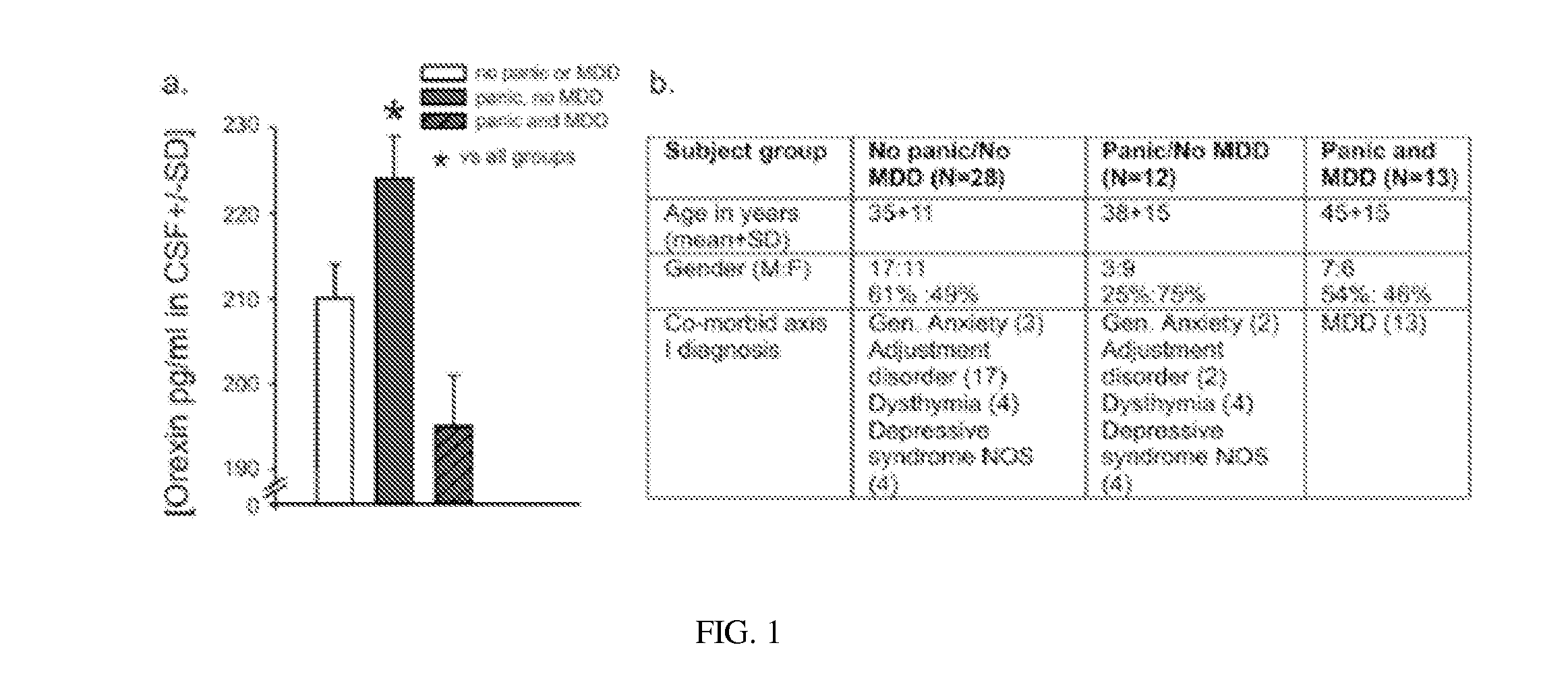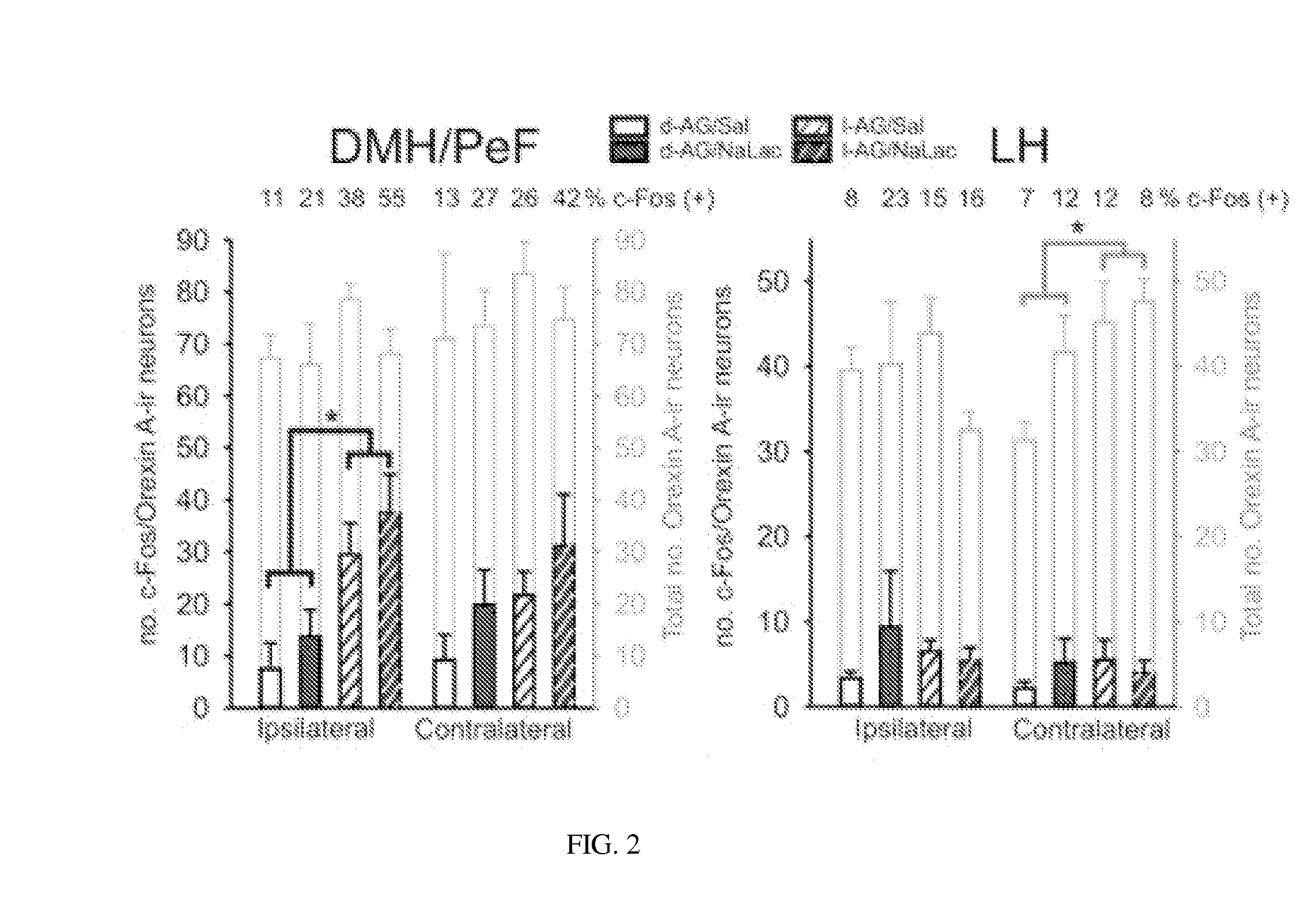Methods and compositions for panic disorders
a technology for panic disorders and compositions, applied in the field of neuroscience and psychiatry, can solve the problems of eliciting panic-like responses, reducing the effect of ph, reducing the risk of suicidal behavior, etc., and achieves rapid increase of extracellular ph, and increase of respiration rate and tidal volum
- Summary
- Abstract
- Description
- Claims
- Application Information
AI Technical Summary
Benefits of technology
Problems solved by technology
Method used
Image
Examples
examples
Example
Experiment 1. Orexin Levels in Human Cerebrospinal Fluid
[0092]To further validate the role of ORX in panic disorder, cerebrospinal fluid (CSF) samples were collected from 53 medication-free patients who presented with suicidal behavior. A cohort of subjects who presented with acute suicidal thoughts / behaviors was systematically assessed with psychiatric symptoms utilizing the comprehensive psychiatric rating scale (CPRS), and item 3 (inner tension) on that scale that assesses panic and anxiety. A threshold cut off at 1.5 on this scale was used to define a patient as having significant panic symptoms. Lumbar punctures were performed to collect cerebrospinal fluid (CSF), and samples stored in −80° C. until assay performed. CSF-ORX-A levels were measured using commercially available 125I radioimmunoassay (RIA) kits (Phoenix Pharmaceuticals) using protocols provided by Phoenix Pharmaceuticals. Duplicate samples were assayed and levels were determined against a known standard. All...
example experiment 2
c-Fos Induction in ORX Neurons of 1-AG and d-AG Treated Rats Following Infusions of NaLac or Saline
[0113]Immunohistochemistry
[0114]Perfusion:
[0115]Methods for perfusion and for verification of cannulae placements in experiment 12 were performed following procedures discussed herein. Briefly, 1-AG or d-AG treated rats received i.v. infusions of either lactate or saline vehicle over 15 min (n=6 / group for 4 groups), were immediately tested in the SI test, then anesthetized and perfused with a 4% paraformaldehyde / 1.5% sucrose solution and processed for immunohistochemistry 90 min following the onset of the i.v. infusions.
[0116]Double Immunohistochemistry:
[0117]In the present study, two of the six alternate sets of 30 μm coronal hypothalamic sections were stained for c-Fos protein (rabbit anti-c-Fos-polyclonal, affinity-purified antibody, cat. no. PC38, Ab-5, Calbiochem; diluted 1:10,000) on day one and then either ORX (rabbit anti-orexin A-polyclonal, affinity-purified antibody, cat. no...
experiment 10.1
Experiment 10. 1-AG Effects on Unconditioned Acoustic Startle
[0147]In experiment 10, rats (n=8 / group) were made panic vulnerable with 1-AG. An acoustic startle reflex was tested the day prior to receiving the 1-AG pump surgeries and 5 days following the onset of the 1-AG pump infusions.
[0148]Adult male Sprague-Dawley rats (n=8 / group) were anaesthetized and had osmotic minipumps (previously filled with 1-AG) stereotaxically implanted unilaterally into the DMH / PeF. An acoustic startle reflex was tested the day prior to receiving the 1-AG pump surgeries and 5 days following the onset of the I-AG pump infusions.
[0149]Unconditioned acoustic startle responses were not altered by 1-AG infusions into the DMH / PeF when comparing responses prior to and after 1-AG infusions (FIG. 23) [there was an increase in the acoustic startle response in both groups due to increases in decibel intensity F(2,28)=29.8, p=0.001; but no overall I-AG effect F(1,14)=0.1, p=0.810; or 1-AG×decibel intensity interac...
PUM
| Property | Measurement | Unit |
|---|---|---|
| Length | aaaaa | aaaaa |
| Length | aaaaa | aaaaa |
| Biological properties | aaaaa | aaaaa |
Abstract
Description
Claims
Application Information
 Login to View More
Login to View More - R&D
- Intellectual Property
- Life Sciences
- Materials
- Tech Scout
- Unparalleled Data Quality
- Higher Quality Content
- 60% Fewer Hallucinations
Browse by: Latest US Patents, China's latest patents, Technical Efficacy Thesaurus, Application Domain, Technology Topic, Popular Technical Reports.
© 2025 PatSnap. All rights reserved.Legal|Privacy policy|Modern Slavery Act Transparency Statement|Sitemap|About US| Contact US: help@patsnap.com



